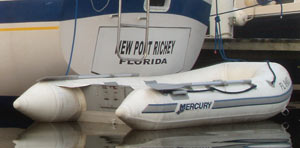 Soft inflatable dinghies have impressive stability and carrying capacity for their size, but tying them to barnacle-encrusted pilings is bad news.
Soft inflatable dinghies have impressive stability and carrying capacity for their size, but tying them to barnacle-encrusted pilings is bad news.A recent overnight trip on a new Catalina 309 reminded me of all the compromises involved in selecting a dinghy for a cruising boat and in bringing it along. The owners have a small inflatable from West Marine, with a semi-rigid inflatable floor and 6 hp Nissan outboard. The dinghy is towed behind, and the outboard stays on a stern rail bracket. A small engine davit from Garhauer makes lifting the engine over onto the dinghy easy. The davit rotates on a ball which is screwed into the aft deck outside the stern rail, and a bracket holds it to the stern rail. The davit can be removed and broken into two pieces for storage, but it is really not in the way on this boat, so it can just stay in place when not in use.
This combination is a great compromise for most purposes. Without the engine, the dinghy is small and light enough to have little effect on the speed of the Catalina 309 under power or sail. We averaged over 6 knots on the GPS, and it's hard to say how much faster we might have gone without the dinghy in tow, but my guess is not much. This type of dinghy can also be deflated and folded up for storage in the cockpit lazarette during offshore passages. In a moderate chop on Charlotte Harbor, it towed along just fine.
Small inflatable dinghies have enormous carrying capacity for their size and weight, and are very stable. Four of us (all adults) went from the anchorage in Pelican Bay to the nearby docks of the Cayo Costa Park. In the small chop of the anchorage, one of the weaknesses of the very small inflatables became apparent. They are wet boats in a crosswind, especially when heavily loaded.
Inflatable Dinghies, Docks, and Barnacle-Encrusted Pilings
When we got to the Cayo Costa docks, although they are fairly recent, we found a nice, crusty growth of oysters and barnacles on the dock pilings. Protecting an inflatable from these is essential. The hypalon rubber is amazingly tough stuff, used on whitewater rafts which take substantial abuse, but oysters are amazingly sharp. We carefully held the boat off the pilings while everyone got off, then tied it out diagonally across the slip, securing a stern line to an outer piling.
Soft Inflatables Have The Shallowest of Shallow Drafts
There was a nearby lagoon we wanted to explore, and another limitation of the tiny inflatable was revealed, as well as another strength. We were fortunate that the lagoon was nearby, because there was no way the little boat would get up on plane with 4 people aboard. Little inflatables like this one will usually plane with one person, and might with two, but that's all. As we approached the lagoon, I saw that edge of the channel leading in was fairly shallow. I love little boats! We went right over it without even stirring any sand, and without the need to tilt the engine into shallow water mode. A tiny inflatable can sneak into the shallowest water, and two people can even pick it up and carry it across small sand bars.
You can get a faster, drier ride from a hard bottom inflatable, but there are trade-offs. It's nice to be able to zip over to an island a couple of miles away through a light chop, and arrive quickly and dry. But it comes with a price. You can't pick up most hard-bottom inflatables and carry them across sand bars. Even a small boat and engine can weigh hundreds of pounds. You can't fold up a rigid inflatable boat, as the name implies. RIBs must be towed behind or lifted on davits, either of which can present problems when making offshore passages. A rigid inflatable is still an inflatable, and still doesn't like oysters, but the alternative is a hard hull dinghy, which comes with its own set of compromises.
Leave a Reply
You must be logged in to post a comment.